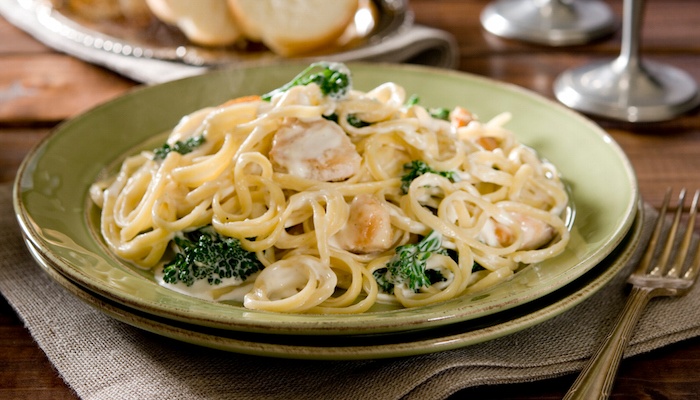 Cream, butter, Parmesan cheese, a little pepper and a dash of nutmeg... Alfredo sauce is a fairly simple recipe that requires just a few primary ingredients and is the perfect complement to Fettuccini pasta. That’s one reason people love it. There’s another reason it’s so popular among consumers:
Cream, butter, Parmesan cheese, a little pepper and a dash of nutmeg... Alfredo sauce is a fairly simple recipe that requires just a few primary ingredients and is the perfect complement to Fettuccini pasta. That’s one reason people love it. There’s another reason it’s so popular among consumers:
It tastes fantastic.
Traditional Alfredo sauce and other cream-based sauces are a delicious combination of fats and oils. Unfortunately, they’re also loaded with fat and calories and can be a real artery clogger.
Consumers Still Care About Fat & Calories
Consumer attitudes toward low-fat foods are changing. More and more health-conscious consumers understand the distinction between good-for-you fats and those that pose health risks. For example, trans fats increase the risk for heart disease and inflammation. The decades-old mantra of avoiding fat content of any kind is hard to dispel, however.
When presented a choice between a full-fat product and a low-fat version, most still choose the lower fat option.
Three out of four consumers indicate they’re eating healthier today than they did 10 years ago, according to the 2019 Food and Health Survey conducted by the International Food Information Council Foundation. Even though recent diet trends have shifted away from meticulous calorie counting, more than 60% of Americans consider the nutritional properties of a product as a key driver in their purchasing decisions and want to cut back on fat and calories.
Taste still remains at the top with 88% saying it's their number one consideration when purchasing food. At the same time, consumers are also drawn to convenient products that fit within the average food budget, adding another layer of difficulty to the manufacturing process.
Why Finding Cream Replacement Options Is So Hard
According to the Code of Federal Regulations Title 21, heavy cream must be composed of 36% or more of milkfat. Milkfat provides the distinct creamy mouthfeel and texture that’s so appealing in cream-based sauces, and also contributes to the unmistakably rich dairy flavor.
Replicating those characteristics and creating the appropriate viscosity — not too thick, not too thin — is a common challenge in the food industry. This is especially true for those who’ve traditionally relied on commodity whey or gums and stabilizers when trying to achieve the right milkfat characteristics.
Simply switching to light cream isn’t a viable option as it will negatively impact mouthfeel and flavor. And any additives will likely include artificial ingredients or modified starches — major offenders on today’s ”no-no list” of food ingredients. Additional challenges arise when a food product goes through various conditions including high shear environments, freeze/thaw cycles or other thermal applications. A common problem that has plagued food formulators is creating a sauce that doesn’t separate, pool or lose viscosity in general.
Using Alfredo sauce as an example, one of the biggest challenges for manufacturers is decreasing cream — the main contributor of fat in the formulation. Cream provides the attributes that give the sauce its signature flavor, texture and mouthfeel. If those characteristics can’t be accurately replicated in the cream replacement, the healthier Alfredo option won’t satisfy consumers—and won’t sell on the shelf.
Product developers and ingredient suppliers are eager to find cream replacement options that provide the tastes and textures consumers love while also improving nutrition and maintaining clean labels by using natural ingredients. They also want to find ways to improve food safety and minimize the inherent risks of using fresh dairy, such as spoilage.
Watch the Video!
How all-natural whey protein works as a cream replacement
Whey Protein — An All-Natural Substitute for Heavy Cream
When consumer demand calls for all the taste and natural goodness of cream, but not all the fat, innovative food manufacturers are turning to an alternative sustainable ingredient.
By formulating with all-natural functional whey protein ingredients, like Grande Bravo®, food manufacturers can replace high-fat, high-calorie dairy ingredients like cream, butter, sour cream and milk in applications. This is perfect for creamy sauces like Alfredo because Grande Bravo provides a unique water-holding capability that helps replicate the same texture and mouthfeel as the original formulation. It also has a clean flavor profile and typically costs less than fresh dairy.
To learn more about how functional whey protein can help food manufacturers improve nutrition in their creamy sauce applications without compromising texture or mouthfeel, read our helpful Guide to Creamy Applications. Just click below to access.




